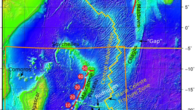
Hotspot tracks and other reference frames for plate tectonics
To understand the interaction of the Earth surface and the deep mantle through geologic time, it is necessary to know the tectonic plate motions over the mantle. The geometry and age progression of hotspot tracks are an important constraint for such plate motions. For example, Figure 1 shows the modelled track of the Reunion plume and some topographic features that have been associated with it. Some of the discrepancies can be explained due to interaction of mantle plumes and lithosphere, especially spreading ridges. How the track formed, as first the Indian and then the African plate moved over the Reunion hotspot can be visualized in the movie on this page. We contribute to improving hotspot reference frames, taking hotspot motion into account. New radiometric age dates along hotspot tracks indicate a rapid southward motion of the Hawaii hotspot between 60 and 50 Ma (Konrad et al., in press). Despite this southward motion, the bend in the Hawaiian-Emperor Chain can only be explained if also the Pacific plate changed its direction of motion (Torsvik et al., 2017). For times before the oldest hotspot tracks (~120 Ma), the Large Low Shear Velocity Provinces of the deep mantle can serve as a reference frame (Torsvik et al., 2014), assuming they have been stable, and Large Igneous Provinces have been sourced from their margins (Doubrovine et al., 2016).
Ph.D. Student:
Former Ph.D. Student:
- Rene Gassmoeller
External collaborations:
Selected recent publications:
- Konrad, K., Koppers, A.A.P., Steinberger, B., Finlayson, V., Konter, J., Jackson, M.G.: On the relative motions of long-lived Pacific mantle plumes. - Nature Communications, in press.
- Torsvik, T., Doubrovine, P. V., Steinberger, B., Gaina, C., Spakman, W., Domeier, M. (2017): Pacific plate motion change caused the Hawaiian-Emperor Bend. - Nature Communications, 8, 15660.
- Doubrovine, P. V., Steinberger, B., Torsvik, T. H. (2016): A failure to reject: Testing the correlation between large igneous provinces and deep mantle structures with EDF statistics. - Geochemistry Geophysics Geosystems (G3), 17, 3, p. 1130-1163.
- Torsvik, T. H., van der Voo, R., Doubrovine, P., Burke, K., Steinberger, B., Ashwal, L. D., Trønnes, R., Webb, S. J., Bull, A. L. (2014): Deep mantle structure as a reference frame for movements in and on the Earth. - Proceedings of the National Academy of Sciences of the United States of America (PNAS), 111, p. 8735-8740.
- Torsvik, T. H., Amundsen, H., Hartz, E., Corfu, F., Kusznir, N., Gaina, C., Doubrovine, P., Steinberger, B., Ashwal, L. D., Jamtveit, B. (2013): A Precambrian microcontinent in the Indian Ocean. - Nature Geoscience, 6, 3, p. 223-227.
Selected press coverage and popular science:

